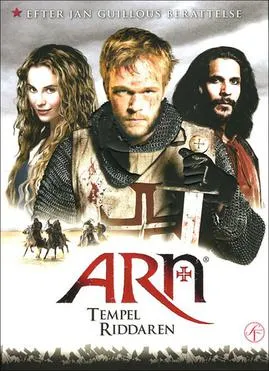Historical accuracy of Arn: The Knight Templar

Historical accuracy of Arn: The Knight Templar

Characters
Arn Magnusson (Joakim Nätterqvist)
The protagonist is entirely fictional, serving as a narrative device to explore 12th-century Sweden and the Crusades.
Cecilia Algotsdotter (Sofia Helin)
A fictional character, possibly inspired by Cecilia Rosa, whose relationship with Arn and subsequent punishment drives much of the plot.
Brother Guilbert (Vincent Perez)
A fictional monk who teaches Arn swordsmanship and archery, providing a narrative reason for Arn's martial skills.
Birger Brosa (Stellan Skarsgård)
Birger Brosa was a real and influential Jarl. His depiction as a key political figure in Sweden is accurate, but his relationship with the fictional Arn is not.
King Knut Eriksson (Gustaf Skarsgård)
A real historical figure. The film depicts his involvement in the Swedish power struggles, though his specific interactions and friendship with Arn are fictional.
Saladin (Milind Soman)
Saladin was the real Sultan. His portrayal as a major figure in the Holy Land is accurate, but his specific encounters and mutual respect with the fictional Arn are not.
More characters
Mother Rikissa (Bibi Andersson)
Rikissa of Denmark was a real queen associated with the era, but portraying her as the specific abbess enforcing Cecilia's punishment is a fictionalization.
Father Henri (Simon Callow)
A fictional character representing the monastic educators in Arn's youth.
Magnus Folkesson (Michael Nyqvist)
Fictional father of the fictional protagonist.
Sigrid (Mirja Turestedt)
Fictional mother of the fictional protagonist, whose vow dedicates Arn to the Church.
Grand Master Torroja (Steven Waddington)
Based on the real Grand Master Arnold of Torroja. Arn serves under him in the film; this specific relationship is fictional.
Story
Arn raised/educated in Cistercian monastery
Based on the fictional protagonist's backstory.
Training by former Templar monk (Guilbert)
A fictional element to explain Arn's fighting prowess.
Arn & Cecilia's forbidden love affair
The core romantic plot is fictional.
Excommunication/penance for Arn & Cecilia
While the specific case is fictional, the film accurately depicts the Church's power to excommunicate and impose severe penance (Crusade/convent) in the medieval period.
Arn forced to join Knights Templar
Arn's joining the Templars is part of his fictional punishment.
Depiction of Knights Templar life/role
Shows Templars as warrior monks defending the Holy Land. Some critics find the portrayal slightly idealized (e.g., less fundamentalist) compared to some historical views.
Political conflict in 12th C. Sweden
The background of warring families (Folkung, Sverker) vying for control accurately reflects the fragmented state of Sweden before its unification.
Battle of Montgisard (1177)
The battle was a real, significant Crusader victory led by the young King Baldwin IV against Saladin. Arn's fictional commanding role in the film is inaccurate.
Arn saving Saladin's life earlier
A fictional encounter establishing a connection between the protagonist and antagonist.
Cecilia's harsh life in Gudhem Convent
While her specific situation is fictional, the depiction reflects the potential harshness, austerity, and internal politics within medieval convents.
Influence of Birger Brosa on Swedish politics
Accurately shows Birger Brosa as a powerful Jarl playing a key role in the political landscape of the time.
Setting
Medieval Sweden (Götaland, 12th C.)
Effectively portrays the rural landscape, developing settlements, and political fragmentation of Sweden during this period.
Holy Land (Kingdom of Jerusalem, 12th C.)
Utilizes Moroccan locations to effectively represent the landscapes, cities (like Jerusalem, Gaza), and Crusader fortifications of the medieval Levant.
Cistercian Monastery Life (Varnhem)
Shows aspects of monastic routine, education, and architecture. Provides a plausible backdrop, though specific details might be generalized for the narrative.
Costumes and Clothing
Generally appropriate medieval styles for monks, nobles, peasants, Templars, and Saracens are used, though perhaps favoring aesthetics over strict accuracy.
Armor and Weaponry
Depicts typical 12th-century gear like mail armor, helmets, swords, shields, and bows. Generally fitting for the era.
Battle depictions (Montgisard, smaller fights)
Combat choreography aims for realism within the context of film action. The scale and tactics of Montgisard are adapted for Arn's fictional role.
Use of multiple languages
Incorporates Swedish, Latin, English (for Crusaders), and Arabic, reflecting the linguistic diversity of the settings, enhancing realism.
Religious atmosphere (Christian and Muslim)
Portrays the strong religious motivations and conflicts central to both medieval European society and the Crusades.
